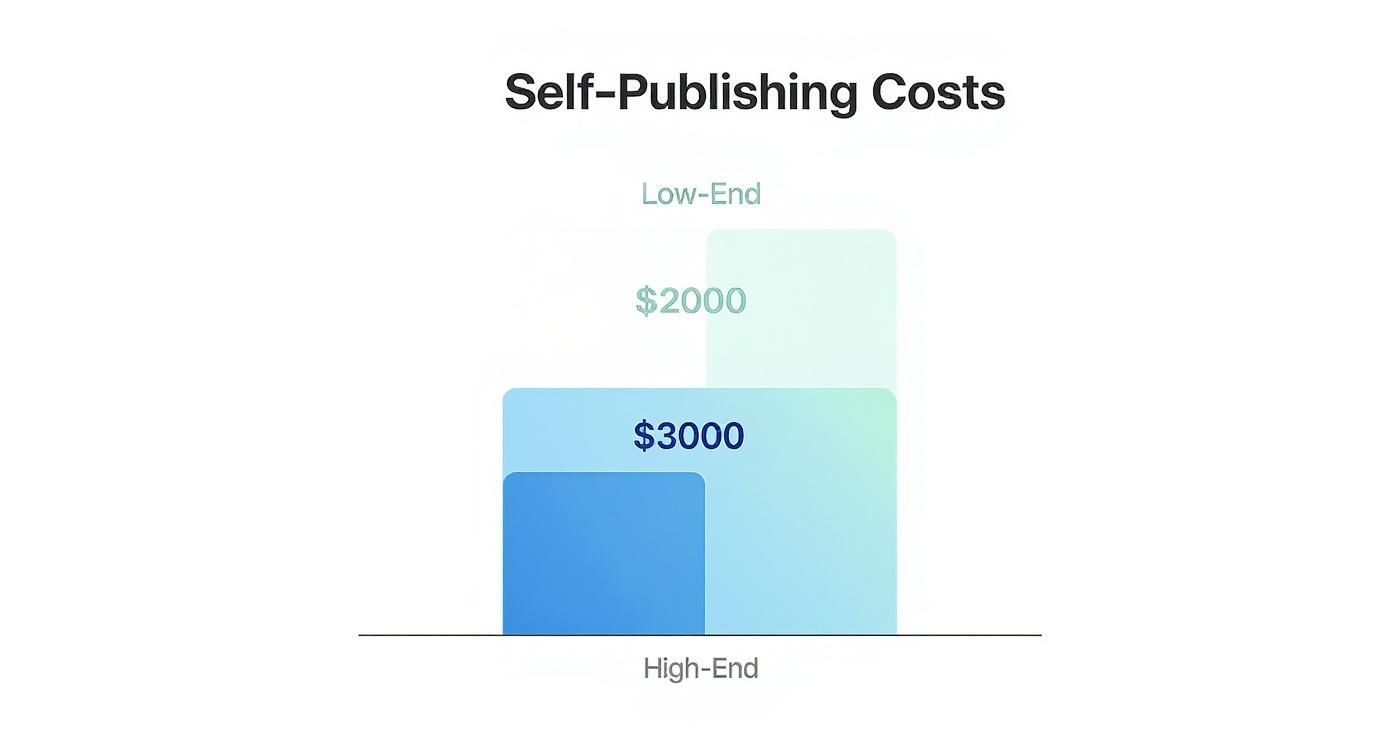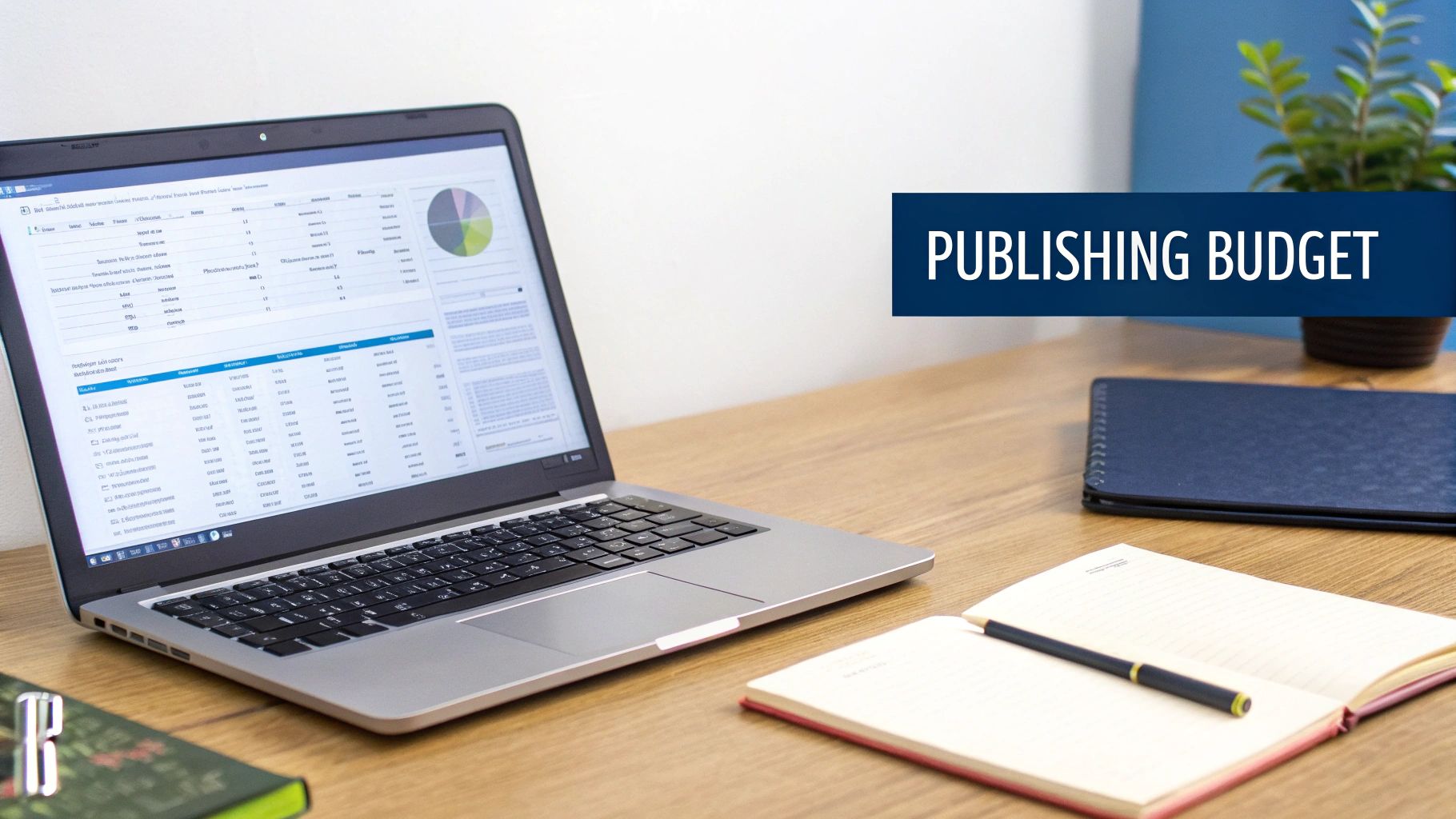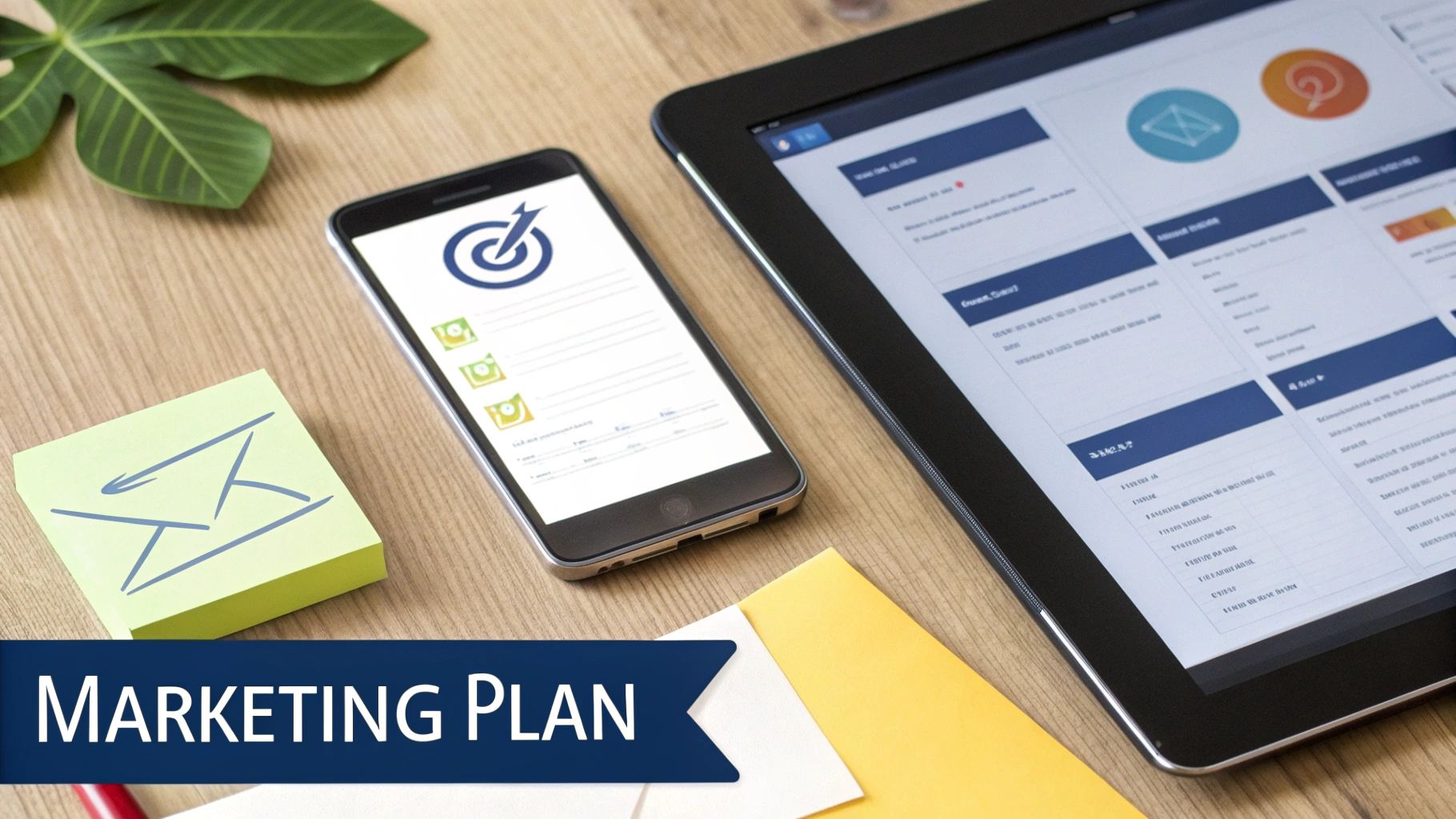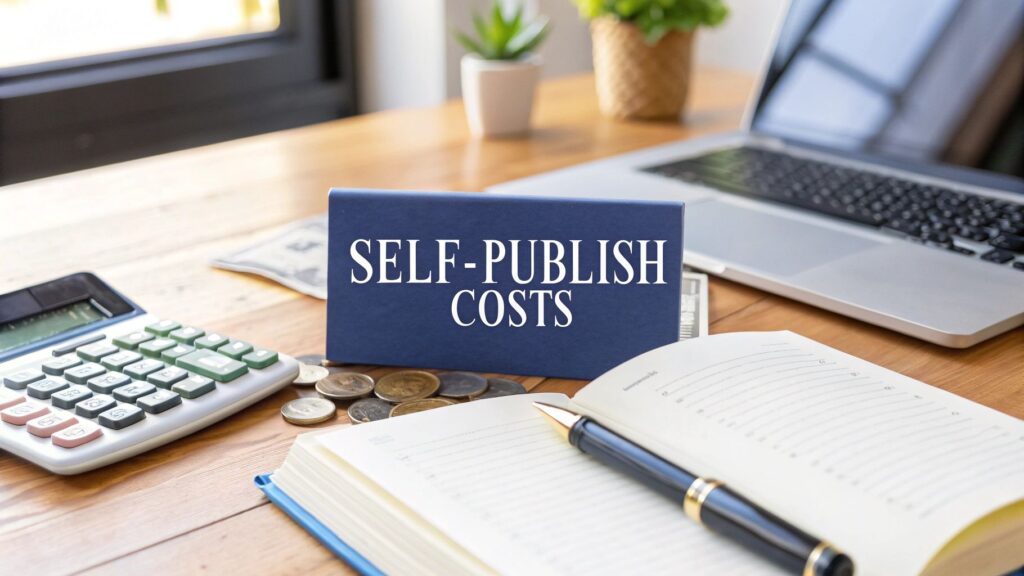So, what's the real cost to self-publish a book that can stand shoulder-to-shoulder with traditionally published titles? You should realistically budget somewhere between $2,000 and $4,000. That range covers the non-negotiables: professional editing, a killer cover design, and clean formatting.
Sure, you can definitely do it for less if you're willing to roll up your sleeves and learn some new skills, but investing in quality is what separates the successful indie authors from the rest.
A Realistic Self-Publishing Budget At A Glance
Figuring out self-publishing costs can feel overwhelming. You’ve poured your heart and soul into writing the manuscript, but now comes the part where you turn that document into an actual, buyable book. How much that's going to set you back depends almost entirely on who you hire to help you.
It's a bit like renovating a kitchen. You could buy the flat-pack cabinets and try to install them yourself to save a buck, but hiring a pro guarantees the doors won't be crooked. The same principle applies here. Investing in a professional editor and a talented designer keeps your book from screaming "amateur," which is crucial for attracting readers and getting good reviews.
Think of these not as costs, but as investments in your book's potential.
The numbers back this up. In 2025, that $2,000 to $4,000 price tag is a solid benchmark. Editing is often the biggest slice of the pie, with prices fluctuating based on an editor's experience and how much work your manuscript needs.
Key Cost Categories To Consider
Your budget will be spread across a few core areas. These are the absolute essentials that directly shape your book's quality and how readers experience it.
- Editing: This isn't just one thing. It can mean developmental editing (big picture story stuff), copy editing (grammar, punctuation, flow), and proofreading (catching those final typos).
- Cover Design: Your cover is your #1 marketing tool. It has to grab a potential reader's attention in a sea of tiny thumbnails online.
- Interior Formatting: A professional layout for both your ebook and print versions is a must. Nobody wants to read a book with weird fonts or clunky paragraph breaks.
- Distribution Fees: This includes the costs associated with getting your book onto platforms like Amazon KDP and IngramSpark. To get a better handle on the fees you'll encounter on the world's biggest bookstore, it's worth reading a comprehensive guide to Amazon seller fees.
This breakdown gives you a good idea of what to expect, from a shoestring DIY approach to a more premium, hands-off service.

To help you see the numbers in a different way, here’s a quick summary of the typical cost ranges for each essential service.
At-a-Glance Self-Publishing Cost Estimates
| Service Category | Low-End Cost (DIY/Budget) | Mid-Range Cost (Professional) | High-End Cost (Premium) |
|---|---|---|---|
| Editing | $500 – $1,000 | $1,500 – $3,000 | $3,500+ |
| Cover Design | $50 – $250 | $400 – $800 | $1,000+ |
| Formatting | $50 – $150 | $200 – $500 | $600+ |
| ISBN & Copyright | $125 – $200 | $125 – $200 | $125 – $200 |
| Total Estimated Cost | $725 – $1,600 | $2,225 – $4,500 | $5,225+ |
As you can see, even a budget approach requires a real financial commitment to cover the fundamentals. And remember, these figures don't include marketing or the actual cost of printing physical copies.
For a detailed look at the printing side of things, our book printing cost calculator can give you a solid estimate of your per-book expenses.
Where Your Money Makes the Biggest Impact

When you're mapping out your self-publishing budget, the sheer number of options can feel overwhelming. It’s easy to get lost. But here’s the secret: not all expenses are created equal. To give your book the strongest possible launch, you have to be strategic and put your money where it counts the most.
Think of it like building a house. Sure, you can save a few bucks on paint or light fixtures, but you’d never dream of skimping on the foundation. In self-publishing, your foundation is built on a few core services that make the difference between a book that looks professional and one that screams "amateur."
These are the non-negotiables. They directly impact whether a reader will even consider buying your book, let alone enjoy reading it. Spending wisely here isn’t just an expense—it's a critical investment in your career as an author.
Professional Editing: The Structural Integrity of Your Book
If your budget only allows for one professional service, this is it. Make it editing. A manuscript filled with typos, plot holes, or clunky sentences is the quickest way to rack up bad reviews and kill your book's momentum. Professional editing ensures your story is not just told, but told well.
But "editing" isn't a single step; it's a process with distinct stages. Knowing the difference is key to spending your money effectively.
The Three Main Tiers of Editing
-
Developmental Editing: This is the big-picture, architectural-level edit. A developmental editor examines the very bones of your story—plot, pacing, character arcs, and overall structure. They’re the ones who ask the tough questions: Is the core conflict compelling? Is the ending satisfying? For an 80,000-word novel, this can run around $2,700.
-
Copy Editing (or Line Editing): Once the story’s foundation is solid, a copy editor steps in to work at the sentence level. They polish your prose, tighten up awkward phrasing, and make sure your voice is clear and consistent. This service for a standard-length book typically costs about $2,000.
-
Proofreading: This is the final quality check before anyone lays eyes on your book. A proofreader is your last line of defense, hunting down any lingering typos, grammatical mistakes, or formatting glitches. It’s the final polish that makes your book shine, often costing around $1,440.
It might be tempting to skip a stage to save money, but that's a classic rookie mistake. Finding a major plot hole during proofreading means you've already paid for copyediting on chapters that now need a complete rewrite. Do it right, do it in order.
To give you a clearer picture of what you're paying for, let's break down the essential services in more detail.
Detailed Breakdown of Core Publishing Services
This table provides a granular look at the costs for different types and levels of editing, cover design, and formatting services.
| Service | Description | Typical Cost Range | Impact on Quality |
|---|---|---|---|
| Developmental Edit | Big-picture feedback on plot, structure, and character arcs. | $2,000 – $4,000 | Critical. Fixes foundational story problems before they get baked in. |
| Copy/Line Edit | Sentence-level improvements for flow, clarity, and style. | $1,500 – $3,000 | High. Elevates the writing from readable to compelling. |
| Proofread | Final check for typos, grammar, and punctuation errors. | $1,000 – $2,000 | High. The final polish that signals professionalism to readers. |
| Custom Cover Design | A unique, professionally designed cover tailored to your book. | $500 – $1,500+ | Critical. Your book's single most important marketing asset. |
| Pre-made Cover | An off-the-shelf, professionally designed cover. | $50 – $300 | Medium. A budget-friendly way to look professional, but lacks uniqueness. |
| Interior Formatting | Professional layout and typesetting for print and ebook. | $250 – $1,200 | High. Ensures a smooth, frustration-free reading experience. |
Understanding these specific costs and their impact helps you build a budget that prioritizes what truly matters for your book's success.
Cover Design: Your Book’s Storefront
In the endless scroll of online bookstores, your cover is everything. It’s your book’s first impression, and you have maybe two seconds to grab a potential reader’s attention. A professional cover instantly signals quality and tells the reader, "This book belongs in its genre."
You have a few routes you can take here, each with its own price tag.
- DIY/Templates ($0 – $100): This is for authors on an absolute shoestring budget who have a good eye for design. It's a huge risk, though—a bad cover can make even a great book look cheap.
- Pre-made Covers ($50 – $300): A solid middle-ground option. These are ready-to-go designs made by professionals. You won’t get a custom fit, but you’ll get a professional look for a fraction of the price.
- Custom Design ($500 – $1,500+): This is the gold standard. You work directly with a designer to create a cover that perfectly captures your book's tone, genre, and story. It’s a serious investment, but it delivers the best results by far.
While a custom design isn't cheap, a fantastic cover can pay for itself many times over in sales. The average price for a professional custom design hovers around $880, an investment that gives your book the credibility it needs to compete.
Interior Formatting: The Reading Experience
A stunning cover gets someone to open your book, but clean, professional interior formatting is what keeps them reading. Nothing pulls a reader out of a story faster than clunky fonts, weird spacing, or awkward page breaks. It’s jarring and frustrating.
This process, sometimes called typesetting, gets your manuscript ready for both digital and print formats. A pro formatter will handle chapter headings, page numbers, and paragraph styles to create a seamless experience for your reader. While you can use free tools, for anything complex (like a cookbook or a nonfiction book with lots of images), hiring a pro is the way to go, costing anywhere from $450 to $1,190.
ISBN: The Official Identifier
Think of the International Standard Book Number (ISBN) as your book’s Social Security number. It’s a unique 13-digit code that officially identifies your book, and you absolutely need one to sell through major retailers, libraries, and distributors.

Here's the crucial part: you need a different ISBN for each format—one for your paperback, another for your hardcover, one for your ebook, and so on.
Some platforms like Amazon KDP will offer you a "free" ISBN, but there's a catch. If you use their ISBN, they are listed as the publisher. To have full control and list your own publishing company (even if it's just your name), you need to buy your own.
In the U.S., Bowker is the only official source. A single ISBN costs $125, but a block of 10 costs $295. The 10-pack is almost always the smarter buy, giving you the flexibility you need for different formats and future books.
Breaking Down Distribution and Printing Costs

Alright, your manuscript is edited and your cover looks fantastic. Now for the exciting part: turning that digital file into a physical book that people can actually buy and hold. This is where distribution and printing enter the picture, and it's a critical step that directly impacts your budget.
Think of it as choosing between two very different business models for your book. Your choice here will define how your book gets made, where it gets sold, and how it lands in a reader's hands.
The Game-Changer: Print-on-Demand
For the vast majority of indie authors, Print-on-Demand (POD) is the way to go. The name says it all: a book is only printed when a customer actually orders one. That means no upfront printing costs, no guessing how many to order, and absolutely no need to fill your garage with boxes of unsold books.
It works just like an on-demand t-shirt shop. You upload your book files, and a company like Amazon’s Kindle Direct Publishing (KDP) or IngramSpark handles all the printing and shipping as orders come in. Then, they send you the profits. Simple as that.
The real magic of POD is how it completely de-risks the printing process. You don't spend a penny on printing until you've already made a sale. For a new author trying to figure out how much it costs to self-publish, that's a massive weight off your shoulders.
This model is a huge reason the self-publishing world has exploded. It has leveled the playing field, giving independent authors access to global markets without needing a huge initial investment.
Comparing the POD Powerhouses: KDP vs. IngramSpark
The two biggest names you'll hear are Amazon KDP and IngramSpark. They both do the same basic thing, but they excel in different areas.
- Amazon KDP: This is your direct line to Amazon’s colossal global marketplace. It’s completely free to upload and publish your book, and they take care of everything on their platform—printing, shipping, and customer service. It's the easiest and fastest way to get your book on the world's biggest bookstore.
- IngramSpark: Think of IngramSpark as your gateway to the rest of the book world. They connect your book to a massive network of over 40,000 retailers, libraries, and online stores, including big names like Barnes & Noble. They charge small setup and revision fees, but their reach beyond Amazon is unmatched.
So, which do you choose? Most savvy authors use both. They use KDP to manage their Amazon sales and IngramSpark for "expanded distribution" to everyone else. This hybrid strategy is a cornerstone of professional book distribution services designed to maximize your book's availability.
How POD Costs and Royalties Actually Work
With POD, you don't really have a "printing cost" in the traditional sense. Instead, it's deducted from your earnings on each sale. The platform takes your book's retail price, subtracts the cost to print it, and then takes its share. You keep what’s left over.
Here’s a real-world example: Let's say you price your 200-page paperback at $14.99 on KDP. The printing cost might be around $3.65. Amazon's 40% share is then taken from the retail price, leaving you with a royalty of about $5.34 per sale. The key is that you never pay that $3.65 out of your own pocket.
The Old-School Alternative: Offset Printing
The other method is offset printing. This is the traditional way, where you print a large batch of books all at once—usually 1,000 or more. The more you print, the lower the cost per book, often dropping to just a few dollars each.
The catch? You have to pay for that entire print run upfront, which can easily set you back $2,000 to $5,000 or more. On top of that, you’re responsible for storing all those books and figuring out how to ship them to customers. It’s a huge financial and logistical commitment.
Offset printing really only makes sense for authors with an established audience and predictable sales, or for those who sell a ton of books at live events. For everyone else, especially first-timers, the risk is just too high. POD is the smarter, safer, and more budget-friendly way to get your author career off the ground.
Creating a Smart Book Marketing Budget
A brilliantly edited book with a stunning cover is only half the battle. If nobody knows your book exists, it simply won't sell. Marketing is easily the most underestimated part of the self-publishing cost equation, but it’s the engine that actually drives sales.
Think of it like opening a new restaurant. You could have the best chef in the city, but if you don't hang a sign out front or tell anyone you're open, you'll be serving an empty room. Marketing is your grand opening announcement, your ongoing effort to bring hungry readers to your door.
This isn't a one-and-done expense; it's a continuous investment in your author career.
Low-Cost and Free Marketing Strategies
You don’t need a massive budget to start making some noise. In fact, many of the most effective marketing tactics are either free or very low-cost. They just require more of your time and elbow grease than your money.
Getting these foundational pieces in place is critical for any long-term success.
-
Build Your Author Website: This is your digital home base. A simple, professional website gives you credibility and a central hub to send potential readers. Costs can range from $60 to $500 per year for a domain name and hosting.
-
Start an Email List: Your email list is your single most valuable marketing asset, period. It’s a direct line to your biggest fans, and it's completely immune to the whims of social media algorithms. Tools like Mailchimp or ConvertKit even have free plans to get you started.
-
Engage on Social Media: Don't try to be everywhere at once. Just pick one or two platforms where your target readers hang out and show up consistently. It costs you nothing but your time.
These organic strategies create a solid foundation, but to really scale your reach, you'll eventually need to put some money behind your efforts.
Investing in Paid Advertising
Paid ads are like putting your book on a billboard right in front of the perfect readers. When you get them right, they offer a direct and scalable way to find new readers and generate sales. The key is to start small, test what works, and then reinvest what you earn.
For most indie authors, Amazon Ads are the best place to start. People are already on the site with their credit cards out, ready to buy books, making your ads incredibly effective.
A common starting budget for Amazon Ads is just $5 to $10 per day. This is enough to gather data on which keywords and cover designs are working without a huge financial risk. The goal isn't to spend a lot—it's to spend smartly by focusing on your return on investment (ROI).
Other popular platforms for authors include:
- Facebook/Instagram Ads: Fantastic for reaching readers based on their specific interests, demographics, and online behavior.
- BookBub Ads: Lets you target the dedicated fans of other authors in your genre, giving you access to an audience of certified bookworms.
Before you spend a single dollar on ads, you need a solid book marketing plan. It’s the roadmap that defines your audience and goals, ensuring your budget is actually put to good use. To make sure every dollar counts, learning about smart digital marketing budget allocation is a crucial part of building that plan.
Advanced Marketing Investments
As your author business grows, you might want to look into higher-level marketing investments to reach an even bigger audience. These options carry a significant price tag and are usually best for authors who already have a few books out and a clear path to profitability.
-
Hiring a Publicist: A publicist can be your ticket to securing media coverage, reviews from major outlets, and podcast interviews. This kind of service can run anywhere from $2,000 to $5,000+ for a single book launch campaign.
-
Book Blog Tours: This involves paying a service to line up reviews and promotional posts across a whole network of book bloggers. A tour can cost $500 to $1,500, depending on how wide you want its reach to be.
Just remember, these advanced strategies are meant to amplify your existing efforts, not replace them.
Realistic Marketing Budget Scenarios
So, how much should you really budget for marketing? Honestly, it depends entirely on your goals and your wallet. Here are three common scenarios to give you a clearer picture:
-
The Bootstrap Budget ($0 – $500): You're all in on sweat equity. This budget focuses entirely on organic strategies like social media, building your email list, and personally reaching out for reviews. Any cash is spent only on essentials like your website.
-
The Growth Budget ($500 – $2,000): This covers all the bootstrap basics, but now you're adding a dedicated budget for running Amazon and/or Facebook ads. You’re actively investing in finding new readers and are laser-focused on getting a positive return.
-
The Professional Launch Budget ($2,000+): At this level, you’re treating your book like a serious business launch. This budget supports robust ad campaigns, a professional blog tour, and maybe even hiring a publicist for a targeted media push.
Calculating Your Potential Return on Investment

Alright, you’ve added up the costs for editing, cover design, and marketing. Now for the big question: can you actually make your money back, and then some? This is where we shift from thinking about expenses to focusing on earnings, and it’s the most important step in figuring out if self-publishing is a viable business for you.
The short answer is yes, absolutely. But it’s not about luck. Profitability comes from treating your writing like a business and understanding the numbers that make it tick.
When you start thinking like an "authorpreneur," your book becomes more than just a creative project—it's a financial asset. And with the right strategy, that asset can pay you for years to come.
Understanding Royalty Structures
As a self-published author, your income comes from royalties. This is simply the percentage of your book's sale price that lands in your pocket. But that percentage isn't one-size-fits-all; it can change dramatically based on the platform, the format (like ebook vs. paperback), and even the price you set.
Think of it this way: selling a digital song download might get a musician a 70% cut, but selling a physical CD through a big-box store might only earn them 40% after the retailer takes its share. Books work the same way.
For example, on Amazon KDP, you can earn up to a 70% royalty for ebooks priced between $2.99 and $9.99. For paperbacks, the royalty rate is 60%, but—and this is a big "but"—that’s before printing costs are subtracted. This is a crucial detail to remember; a higher list price doesn’t automatically mean you make more profit on each sale.
What Does Author Income Actually Look Like?
So, what kind of money are we really talking about? The income range for indie authors is huge, but the trend is pointing sharply upward. More and more self-publishers are seeing their earnings grow.
A 2023 survey from the Alliance of Independent Authors (ALLi) found that the median annual income from self-publishing hit $12,749 in 2022. That’s a massive 53% increase from the year before. The mean income was even more impressive at over $82,600, which shows just how well the top earners are doing. You can dig into all the details in the full ALLi survey.
It's important to know the difference between median and mean income. The median is the midpoint—what a "typical" author earns. The mean gets pulled up by the handful of authors earning six or seven figures. The real takeaway here is that earning a solid, middle-class income from your books is more achievable than ever.
This data really helps to bust the old "starving artist" myth. With a smart, business-minded approach, self-publishing can be a legitimate and sustainable career.
Key Drivers of Profitability
Getting a positive return on your investment isn't about finding one secret trick. It's about consistently applying a few key business principles. Authors who successfully turn their writing into a career almost always focus on these three pillars.
-
Smart Genre Selection: Let's be honest, some genres just sell better than others. Romance, fantasy, and thrillers have huge, hungry readerships that are constantly looking for their next fix. Writing in a popular genre with clear reader expectations gives you a built-in audience from day one.
-
Effective and Consistent Marketing: Your book won't sell itself. Profitable authors are also good marketers who know how to reach their ideal readers. They don't just run a few ads during launch week; they build email lists, stay active on social media, and use advertising to keep their books visible long after the launch buzz has faded.
-
Building a Backlist: This is probably the most powerful tool for building long-term wealth as an author. One book can make you money, but a backlist of several books turns your writing into a scalable business. Every new book you release acts as a commercial for all your older ones, creating a powerful snowball effect that grows your income exponentially over time.
Common Questions About Self-Publishing Costs
When you start digging into the world of self-publishing, a few key questions about the financial side always seem to pop up. Let's tackle the most common ones I hear from authors so you can plan your budget with a bit more confidence.
Can I Really Self-Publish a Book for Free?
The short answer is yes, you technically can. Platforms like Amazon KDP let you upload your manuscript and hit "publish" without spending a dime. They'll even give you a free ISBN.
But here’s the reality check: "free" is not the same as "professional." Publishing a book without investing in professional editing or cover design is a bit like showing up to a job interview in your pajamas. You're there, but you’re not making the right impression.
A book published for free almost always looks like it was free. Readers are savvy—they can spot an amateur cover or an unedited manuscript from a mile away, and it’s an instant dealbreaker for most.
If I Only Have Money for One Thing, What Should It Be?
This one's easy. If your budget is stretched thin and you can only afford to invest in one service, make it editing. Hands down.
A fantastic cover might earn you a click, but a story full of plot holes, confusing sentences, or glaring typos will earn you a one-star review. Readers are incredibly forgiving of many things, but a poor reading experience isn't one of them. Bad reviews almost always circle back to bad editing, and that's a reputation that sticks.
- Editing fixes the core product. It makes sure your story works, flows well, and is clean enough to let the reader get lost in it.
- A great cover can't fix a broken story. No amount of brilliant design can salvage a book that's frustrating to read.
A professional cover is a very, very close second, but editing is the one investment that truly protects your credibility as an author.
How Much Should I Budget for Marketing After Launch?
Marketing isn't a "set it and forget it" expense. Think of it as an ongoing effort to keep your book visible to new readers. A great place to start is with a small, manageable budget that you can scale over time.
A good rule of thumb for authors just starting with ads is what I call the 10% Guideline. Simply plan to reinvest 10% of your monthly royalty earnings back into your marketing efforts. So, if your book brings in $300 in royalties this month, you’d set aside $30 for next month's ads.
This approach is smart for a few reasons:
- It’s Scalable: Your ad spend grows naturally as your sales do. You won't find yourself pouring money into a book that isn't selling yet.
- It’s Low-Risk: You’re only spending money the book has already earned, which keeps your personal financial risk to a minimum.
- It Builds Momentum: Even a small, consistent ad spend keeps your book in front of potential buyers, which can create a slow but steady sales momentum.
The goal isn't to throw a bunch of money at ads right away. It's to spend smartly, learn what works, and build your readership over time.
At BarkerBooks, we guide authors through every step of this journey, from manuscript to marketplace. If you're ready to publish a professional book that stands out, explore our services at https://barkerbooks.com.
